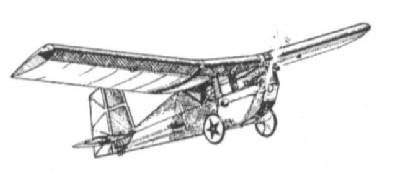SKY PUP NEWS

Newsletter No. 21 Fall 1988
- Simple Happiness Flying in Quebec
- Indiana Sky Pup Flying
- Orphan Sky Pup Kit Completed
- Construction Tips from Simple Happiness
- First Flight of Le P'tit Bonheur
- Update from Al Clement
- Loose Wing Bolts?
- Miscellaneous
-------------------------------------------------
SKY PUP NEWS is a quarterly newsletter for builders of the Sport Flight “Sky Pup”. the purpose of the newsletter is to provide for the open exchange of information and to encourage builders to share their experiences of building and flying the Sky Pup. Beginning with this issue, the newsletter will be written by Sky Pup builders and enthusiasts. Unless specifically stated, all ideas, suggestions and building tips are strictly the opinion of the contributor and have not been approved by Sport Flight Engineering Inc. No warranty is made as to the airworthiness or suitability of modifications or building tips. When in doubt, you should follow the plans as close as possible and contact Sport Flight Engineering if you have questions. SKY PUP NEWS is compiled and distributed by Dan Grunloh…Rt 2, Box 82, Potomac, Illinois, 61865. Subscriptions are $7.00 for the calendar year ($10.00 overseas). If you want to talk about the Sky Pup, or about airplanes and homebuilding in general, please feel free to call m at (217) 569-2121 late evenings. Please keep sending your letters and photos.
Simple Happiness Flying in Quebec
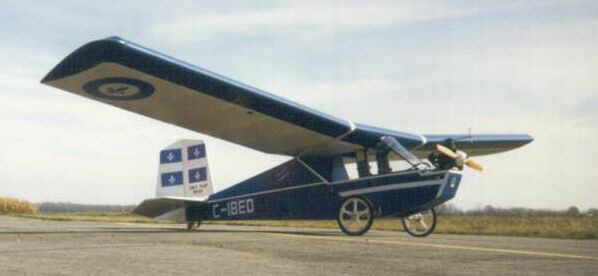
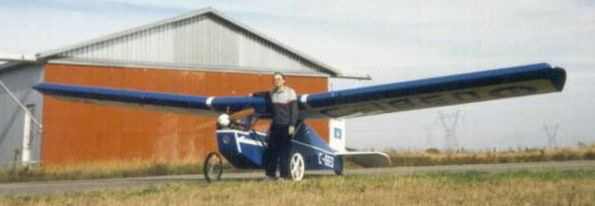
Andre St. Pierre from Pointe du Lac, Quebec, reports he made his first flight of his Pup (SN3099) on October 21, 1988. The entire project took one year to complete. See also newsletter no. 19. He calls his plane "Le P'tit Bonheur" which is the title of a famous Quebec song meaning "Simple Happiness". He likes the name because it's a small plane built with a small budget an resources but which gives so much fun and enjoyment. This Pup is the 6th Sky Pup complete and flying in Quebec. The engine is a Konig 3-cylinder radial of 24HP with a direct drive adjustable prop which turns 4200 RPM max. It works great! The weight came to 240 lbs due to the use of heavier Dow foam, thicker plywood on the D-cell, Douglas fir used throughout the airframe, and extra plywood on the forward fuselage. With a full load of fuel (6 gal) and hi weight of only 145 lbs the total launching weight is 425 lbs. The colors of this Pup are blue and white (the national colors of Quebec) with the Quebec flag on the rudder and roundels on the wing. The Pup has a steerable tailwheel, a tail light on top of the vertical fin, and a set of skis ready for winter flying. A small trim tab was added to the rudder after the first flight to correct left-turning tendency. Andre says he got a lot of good advice from nearby Sky Pup owner Paul Pontois and Jean-Claude Hivon. In fact, he will share a hangar with Paul (two Pups in on doghouse!). Paul Pontois had just returned to Quebec after a year of absence and he told Andre, "You built it exactly the way I would have done it if I had to do it again." Andre says he is a brand new pilot with only 20 hours of flying time (10 hours were in a 3-axis Spectrum Beaver). He found it rather easy to get acquainted to the feel of the Sky Pup. See "First Flight of Le P'Tit Bonheur" for his first flight details.
Indiana Sky Pup Flying
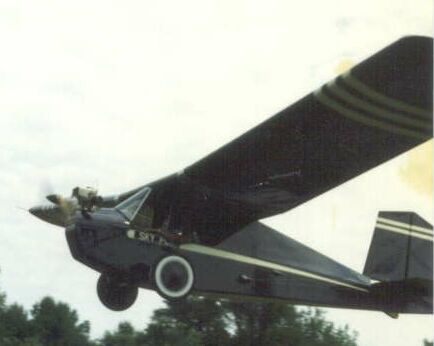
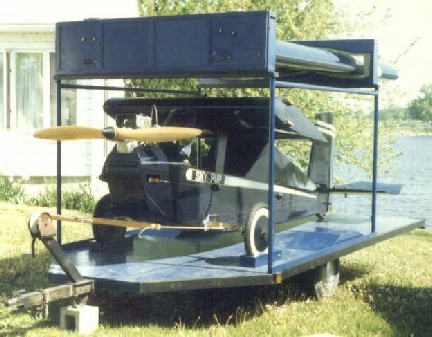
Donald Diggs, of Monon, IN reports he made the first flight of his Sky Pup on June 27, 1988. The colors are navy blue with white trim and the engine is a Rotax 277FA (see issue no. 13). The empty weight is 225 lbs and the CG came out to 4.9 inches. Donald's Sky Pup has some refinements which are typical of the quality and extra effort put into this airplane. The landing gear axle clamps are machined in two pieces from 7075 T6 aluminum. The bottom piece i drilled for cap screws and the upper half is threaded to take the bolts which are safetied. the axle tube is shortened 4 inches and is pinned to the landing gear to prevent sliding in or out. 2 gal. fuel tank was made from 3003 (soft) aluminum and is mounted behind the main spar below the shear panel with seat belt webbing. A sight gauge is in clear view of the pilot and the filler neck extends above the wing. The cowling is made of foam and plywood and is attached with aluminum angles and wood screws. The windshield is attached to each half of the split cowl with aluminum brackets and also has a spring loaded latch at the top. The windshield ca be easily removed in a few seconds. The muffler clamp on the landing gear is made from 7075 T6 aluminum. The top half is hinged and padded for the muffler and is held shut with a coil spring. He says the trailer works fine as he pulled it about 110 miles round trip for the first flight without any problems. The wing boxes are airfoil shaped and are lined with high density foam.
Orphan Sky Pup Kit Completed
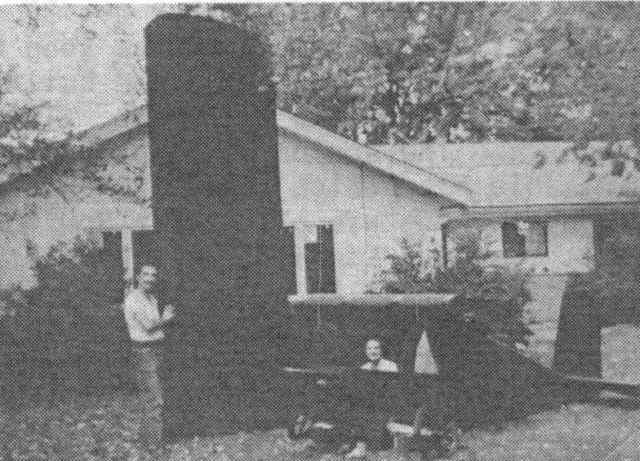
Jim Leibich, of Hoffman Estates, IL reports that he is only a couple of weeks away from taxi testing his Pup. Jim says he bought the kit from a builder in Green Bay, WI who previously bought the kit from a builder in Newburgh, IN. It's nice to hear this puppy finally found a goo home and will soon come to life and take to the sky. The color is bright red with black wheel and the engine is a Zenoah G25A with belt drive. Initial weight and balance put the CG at 2 inches so some weight will be added to the tail. The orphan Pup was built in his family room and was removed through a 4x12 foot hole in the wall which was his south window (he says h sort of wanted to replace those windows anyway). The photo above was from a preliminary setup. An unusual feature is the wing attach uprights which are square aluminum tubing instead of wood. A tube also runs across the bottom under the seat. A 1/8 inch cable runs thru the tubing to connect to the bridle of a ballistic parachute which is mounted on the seatback bulkhead.
CONSTRUCTION TIPS FOR SIMPLE HAPPINESS
Andre St. Pierre got some good advice from Jean-claude Hivon on fabric covering. It has been discovered that the plain white dacron sheath lining will shrink almost twice as much as the colored variety. Actual test samples were shrunk and measured. Apparently, the colored types receive heat or chemical treatments to set the dye which reduces the amount of shrinkage available later. ''Simple Happiness'' was covered with white fabric and then painted (2 coats by brushing) with colored urethane enamel. The first clear coat included aluminum paste to provide sun protection. The fabric was attached with ''LePage'' latex contact cement. Andre also discovered that a small hair dryer works great to dry the glue quickly and stick the fabric permanently when and where you want it. He covered the entire airplane ''solo'', with no help, by using this method.
The main fuel tank is a wedge shaped 5 gal. snowmobile tank mounted just behind the backrest of the seat. The tank is sealed inside a heavy gauge plastic bag which has a drain thru the lower panel in case there is a leak. 2 reserve fuel tank of 1-1/4 gal. from a racing kart is mounted under the front forward deck. The total capacity of 6-1/4 gal. gives an estimated 4 hours of flying time with the Konig engine. The center of gravity varies from 7 inches (behind the main gear) when empty, to 10 inches with a full load of fuel.
The hole in-the floor is closed with strips of 3 inch wide elastic bands (used in clothing manufacture). The bands are glued over the hole lengthwise and overlap each other by half the width. This gives a permanent step thru panel. You only have to pass your foot and leg thru the elastic bands. When you pull your foot out the elastic bands close one over the other. Works great!
A removable front canopy was built up from 1/2 inch pine sticks in the method used by Jean-Claude Hivon. Clear plastic sheeting was attached to the frame with double surface sticking tape. The weight of the frame was only 1-1/2 lbs. The canopy really improves the look and the comfort during cold winter flying.
The front fuselage is laminated inside and out with 1.5 mm aircraft plywood on the sides forward of the wing uprights and the floorboard is laminated on both sides with 1.0mm plywood for extra strength. The plywood was clamped to the fuselage sides using a vacuum bagging technique common to composite aircraft. He first built a 4 mil polyethylene bag to fit each side with connections to attach to a vacuum line. Epoxy was spread on the sheets of plywood and they were positioned on the sides and the vacuum bag was installed and sealed. A vacuum pump was attached and pulled down to roughly 12 psi for 8 hours. Both inside and outside were done together so the front of the fuselage was pulled together before the glue set to get the required curve.
A steerable tailwheel was installed using an idea he picked up from the newsletter but he came up with a new idea to drive the wheel. The tailwheel steering is connected to a point on the underside of the rudder about 6-8 inches aft of the rudder spar. A spring is used to absorb shock loads. It's simple and works great.
If you have questions about Le P'tit Bonheur, you can write to Andre directly. Also, he will translate to French for anyone who wishes to contact Jean-Claude Hivon. The address is:
Andre St. Pierre
511 Place Montour RR2
Pointe du Lac, Quebec GOX-IZO
(newsletter no. 21)
FIRST FLIGHT OF LE P'TIT BONHEUR
by Andre St. Pierre
I made the first flight on Friday October 21, 1988. I had taken a day off from my job having in mind to perform the first ground test and taxi test only. Just enough to get acquitted with the plane and make any needed corrections and adjustments. My wife came along to give a hand if needed and to have a look at the plane she had seen built up piece by piece in our basement.
I started taxiing with the Pup, and it took not more than 3 runs down the airstrip to get the feel of it. My Pup was easy to handle on the ground due to its directional tailwheel. I can turn within the width of the airstrip and go where I want with a high degree of precision. This astonished me because of what I had a read about the difficulties of taxiing a taildragger.
The absence of brakes did not bother me and I learned very fast how to slow the Pup by cutting the engine and grasp a wheel (with a glove). I have an electric starter to put the engine back in operation. In last resort, I just direct the plane into the grass at the side of the strip and there it stops. If it keeps going like this, I may not install brakes.
After taxi tests, I had planned to do just fast taxi and maybe small jumps from the ground. There too, it just went right on and I kept doing jumps a little higher and longer. After 5 or 6 runway lengths of these tests, I was ready. As I was thinking and hesitating, my wife supported me, and we made the decision to put ''Le P'tit Bonheur'' in the air for good. And that was it! I was at the beginning of the runway and I pushed the Konig to full power, accelerated, and suddenly.... Woops! I was climbing and climbing.
I made the first circuit at 500 ft. trying to pull sideways on the stick like H---! (I got used to it fast) and came back down to land like a flower just in front of my wife-… What a feeling....for both of us!
I have about 5 hours of flying time and the more it goes, the more I appreciate my Sky Pup, and I am looking for years of nice flying and fun. I am very grateful to Steve Wood who designed such a nice plane for people like me.
Update from Al Clement
A.R. Clements from Sechelt BC Canada writes that he is having a great time with his Sky Pup and has logged 91 hours to date (see newsletters 17 & 18). All but 7 hours were logged since April 26, 1988 so you can see what he has been doing lately. The Pup shows no signs of wear and he is still flying with the original spark plug. The only problems have been damage to the lower longeron under the axle due to a hard landing and deterioration of the plastic impulse line to the fuel pump (this line should be extra heavy duty heat resistant). Al says that he is retired and that he and his wife camp at the flying field in a motor home and also bicycle, canoe, and hike in the nearby mountains. He avoids flying in the middle of warm sunny day as it is too bumpy and he likes to do real low flying. There are about 18 other ultralights base at his field and the other pilots sometimes snicker and call his Pup the "Fred Flintstone Plane". He feels the Sky Pup puts all the other flyers with their $18,000 Beaver amphibians to shame. While they spend their time on the ground polishing and repairing, he is doing circles and figure eights overhead and zooming over the treetops. Al says he can do circuits just using rudder and throttle. He puts rubber bands over the stick to hold it back slightly and also use this method for aerial photos. He feels the Sky Pup would look better with a tricycle gear and stronger floor so you could step onto it but he would retain the 2-axis control. It works just fine!
Loose Wing Bolts?
It has come to my attention that some Sky Pup owners have detected free play at the wingtip which is traced to slack in the wing joint. It is usually not detected unless you have someone hold one wingtip steady while you lift upward on the other. I checked my own Pup an discovered about one inch at each wingtip or two inches if the play in both wings are included. A phone call to Sport Flight cleared up some concerns about this problem.
Some free play is to be expected at the wingtip even on a new Sky Pup which is correctly built. Calculations will show that even a few thousandths of an inch of free play at each upper an lower wing fitting will add up to an inch or more when translated out to the wingtip. Also, although the wings are quite rigid, the spars will deflect 1/4 inch or more when the weight of the Pup is supported at the wingtip. It is of course important to avoid drilling the holes in the fittings oversize when constructing the fitting. It's best to drill the holes slightly undersize an then ream them out to 3/8 with a hand reamer. Tightening the nuts on the wing bolt excessively will not remove the free play and should best be avoided. Also, a washer should be used under the head of the bolt.
In most cases the cause of the free play will be traced to wear on the bolts due to repeated removal and insertion without lubrication. The bolts on my Pup were very tight and hard to insert when new, but the wings have been removed and replaced 16 times in 3 years and the bolts are now much looser and visibly worn. Wing bolts should be lubricated with light grease and avoid twisting motion when inserting which can increase the wear.
If you have 1 to 2 inches of free play at the wingtip it is no cause for concern. If there is considerably more you might try a new set of wing bolts especially if yours are visibly or measurably worn. If the free play is really excessive (in the range of 4-5 inches), the impact loads on the fittings when flying in strong turbulence are the main concern. Worn bolts will eventually cause the holes in the fittings to become egg-shaped. If the holes in the fitting become worn oversize, the fittings must be replaced (not as difficult as it sounds). The next largest bolt size (7/16) would probably leave too little margin on the fitting and the cost to have special wing pins made only slightly oversize would be very great and would require precision machine shop work.
Miscellaneous
A number of new Sky Pup projects have been started this year. I recently received update from Archie Robertson of Indianapolis, IN, from Alexander Campbell from Port Huron, MI, and from Rex Rhode from Monticello, WI. Rex sent photos of the completed tail and nearly completed fuselage.
Dean Lowe of Waco, Texas recently purchased a completed Rotax powered Sky Pup. It was built by an A&P mechanic as a school project but was never flown. Dean plans to fly it for time and then sell it. If interested, his address is: Rt. 5, Box 869, Waco, TX 76705 (will have photos next time).
Paul Pontois has moved back to Quebec after a year of absence (see issue 18). He is back a his old address: 1890 Range-des-Chutes, Ste-Ursule, Quebec J0K 3M0
The next issue will have updates from Newton Borden (issue 17) who is still flying his Pup an says he is glad he didn't sell it. Also, news and photos from Neil Huizenga (issue 17 & 20) wh has been flying the first plans-built Sky Pup.
Dear Sky Pup enthusiasts...I want to thank everyone who sent photos and letters about you Sky Pup. There would be no newsletter without your help. Sadly, there is not enough time to answer each letter individually. I try to respond to those which have a specific question or problem. I do read and save everything. If you have a question that I forgot to answer, or if you would like me to return photos, please call or write. The photos I keep go into a special Sky Pup album which will become part of the Sky Pup history. THANKS AGAIN....Dan

SKY PUP NEWS

Newsletter No. 22 Winter 1988/89
- Wisconsin Sky Pup Flying
- More Pups Completed in 1988
- More Tips on Loose Wing Fittings
- Tips on Hotwiring Foam Ribs
- Letter from Newton Borden
- Update from Greg Pardee
- First Plans Built Sky Pup
- Rotax 277 Keeps Running After Engine Shutoff
- Bubbles/Blisters Under Fuselage Fabric
Miscellaneous
------------------------------------------------------------------------------------------------------------------
SKY PUP NEWS is a quarterly newsletter for builders of the Sport Flight “Sky Pup”. the purpose of the newsletter is to provide for the open exchange of information and to encourage builders to share their experiences of building and flying the Sky Pup. Beginning with this issue, the newsletter will be written by Sky Pup builders and enthusiasts. Unless specifically stated, all ideas, suggestions and building tips are strictly the opinion of the contributor an have not been approved by Sport Flight Engineering Inc. No warranty is made as to the airworthiness or suitability of modifications or building tips. When in doubt, you should follow the plans as close as possible and contact Sport Flight Engineering if you have questions. SKY PUP NEWS is compiled and distributed by Dan Grunloh…Rt 2, Box 82, Potomac, Illinois, 61865. Subscriptions are $7.00 for the calendar year ($10.00 overseas). If you want to talk about the Sky Pup, or about airplanes and homebuilding in general, please feel free to call m at (217) 569-2121 late evenings. Please keep sending your letters and photos.
Wisconsin Sky Pup Flying

Todd Douma of Hortonville, Wisconsin reports that after 4-1/2 years of construction he has completed and flown his Sky Pup SN1916. During that time he also built a new house and moved from Appleton to Hortonville. This Pup is blue with white trim and the wheels are black. The sunburst pattern on the tail should help visibility. The engine is a 340 Kawasaki with Rotax gearbox using a custom mount of his own design. The weight came out to 229 lbs and the CG was well within range. The total cost to build was only $1500 and he gives thanks to Steve Wood for designing it that way. The finish was 2 coats clear varnish, 6 coats of clear with silver, and Pratt and Lambert Jet-glo as the final color. Todd says some unsightly bubbles and blisters formed on the fuselage during the heat of the summer of 1988 (see later in this issue for a discussion of bubbles in fabric cover). The first taxi tests were on May 30, 1988. He had few carburetor and exhaust problems but had them worked out by the 20th of June and went t do some more ground runs. Here's the story of his first flight; "It was a perfect day, quiet and warm. I was using my dad's hayfield where I keep my Pup. the field was pretty rough so instead of risking damage from taxi runs, I decided it might be safer in the air. Full power into the wind lifted the Pup sooner than expected and I found mysel climbing quickly. At several hundred feet I throttled back and the engine all but died! Carburetor problems again. I managed to keep the engine running but only at 3/4 to full throttle. With some fancy throttle control and a prayer, we managed one circuit and came in for an interesting landing. The excitement only heightened the feeling I am sure only those of u who have built and flown their own airplane can comprehend. The awesome feeling an satisfaction!!! Since then my Pup and I have acquired about 25 hours of fantastic and fun flying including some engine off gliding. I put it away for the winter and plan to do a inspection on the engine and gearbox seeing as how much of the installation is one-of-a kind"........Possibly, we will get a chance to see this Pup at a future Oshkosh convention a Todd would not have to travel as far as many of us.
More Pups Completed in 1988

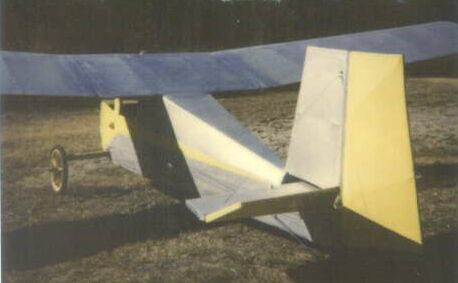



The photos above are from William Parker of Eastman, GA who writes that his Rotax powered Pup SN2881 is now completed and has had some taxi work. The covering is Stits polyfiber and the color is yellow and silver, but the paint scheme is not yet completed. A fiberglass fuel tan is built into the centersection. He says he first broke a prop while taxiing in a dirt field but got replacement. On the next attempt, the Pup started to lift, but in his excitement he drifted to on side and hit a firebreak plowed by the forest rangers. WHAM! The wheel busted, the axle broke, and another prop was in a thousand pieces. He has since replaced the wheel and axle, and mounted a 3-blade Ultraprop. Ready to go again as soon as runway construction i completed. He modified the landing gear by bolting a steel bar under each end of the woo axle. These metal straps are bent down to vertical at each end of the axle to mount the wheel. The result is much more prop clearance.
Tom Hogan of Oak Ridge, Tenn sent the photo at left of his nearly complete Pup mounted on its trailer. The Pup was covered with Dacron 103 and painted with Blue River Filler coat #7601 followed by Benjamin and Moore latex enamel. The colors are Linen White and Royal Blue. The cockpit is mauve. The engine is a used Rotax 277 which had only 21 hours on an Aerotique Parasol. The engine cost $450. Still needed are the controls, fuel tank, fairings, seatpad, and some warmer weather so he can fly it.

More Tips on Loose Wing Fittings (see also newsletter 21)
(Editor's Note: this modification is not approved by the designer of the Sky Pup. Do no attempt this modification without doing the engineering to check the effects of this procedure!)
Dave Beres of Keizer, OR sent this excellent tip for anyone who has excess play in the wing joint which can not be cured with new 3/8 bolts. Note that 10 MM metric bolts are .393 inches in diameter as compared to .375 for the 3/8 bolt. Reamers are available at any good tool supply house. You have to go to industrial bolts which come in grade 5 (comparable to aircraft grade), or in grade 8 which is considerably stronger. Dave says it is his personal opinion that "aircraft grade is absolute bologna! It's a bolt made by a manufacturer who went through all the paperwork. He doesn't have a superior bolt, just superior paperwork." Anyway, a 10 MM bolt and reamer would cost a lot less than custom machined wing pins and would be much easier than replacing the fittings. Note that only .018 inches would be removed from the fitting. You may have to drill a cotter hole in these bolts. Also, check the thread length which may b different than aircraft bolts.
TIPS ON HOT WIRING THE FOAM RIBS
A number of builders have written that they have had difficulty setting up a satisfactory hot-wire. Though the process is very simple, you will have to experiment to find the right combination of power source and cutting wire. the photo below shows a simple wood frame I used for the hot-wiring. Any type of frame will work but it should be strong and should include a spring or some device to keep the wire tight when it gets hot and stretches. A loose hot-wire will bow when pulled thru the cut and result in errors.
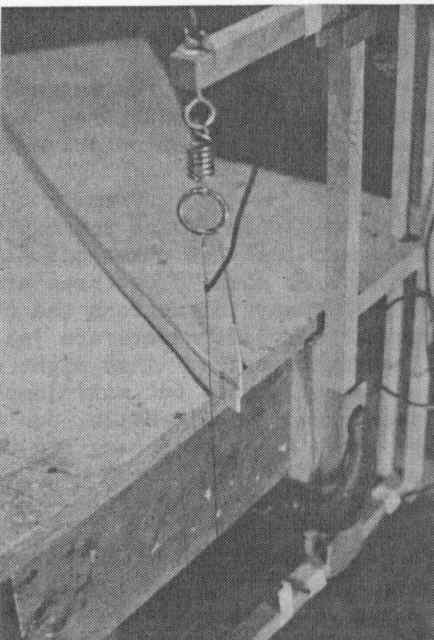
In the top photo, my hot-wire is clamped perpendicular to the work bench. The template is stuck to the foam piece with carpet tape. The small bumps at the trailing edge are an old model airplane building tip. They mark the exact location for cutting off the tip later, and provide a little extra thickness to be sanded off after the trailing edge is bonded in place resulting in a better fit.
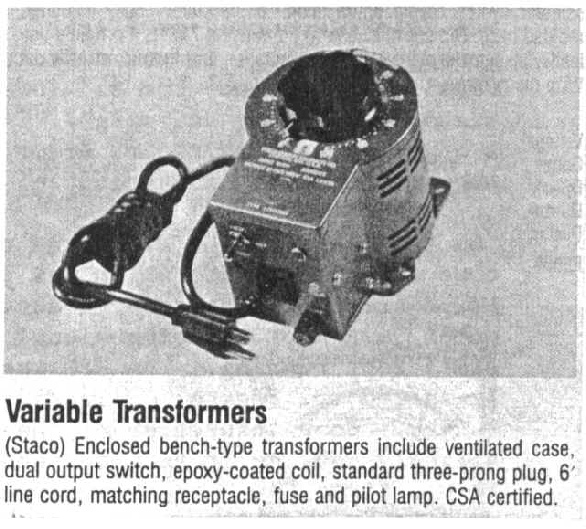
Builders have reported trouble with the hot- wire burning off or the transformer or power source burning up. The ideal power source is a "variable transformers like that shown below. They are available from Wicks but are too expensive. Try to borrow one. A battery charger or train transformer should work. The secret is you must match the thickness and the length of the wire with the capacity of your power source. If the wire is too heavy or too short, there will not be enough resistance, and the transformer will overload.
For my setup, I used .025 safety wire, a voltage setting of about 10 to 12 volts, and about 15 inches of wire was heated. When it came time to hotwire the underside of the centersection diagonal and nose ribs I found I had to build another frame long enough to span the distance but the length of heated wire stayed the same.
Some builders may be trying to run the wire too hot. Excess heat will cause the foam to melt away from the wire at the surface of the cut. The edge of the cut will not be square. A slow patient cut which results in the typical "angel hair" will give the best results. With too much heat the wire will burn out more often as will the connection between the power source and the cutting wire. With too little heat there is a greater tendency to bow the wire while trying to pull it through.
If all this seems too much, some builders have reported cutting the ribs with a bandsaw, and with an electric carving knife? Only the rib and spar foam needs to be hot-wired. The rest of the foam in the airplane is cut with a knife. You could probably cut the ribs oversize with a knife and then sand them down to shape. The hot-wire is the fastest way and is a lot of fun once you get it working.
LETTER FROM NEWTON BORDEN OF SO. WEYMOUTH, MASS.
Dear Dan,
I have enjoyed flying my Pup all summer and am glad I didn't sell it. Other than a deteriorating fuel line, I have had no problems. I mounted a VCR camera on the right side on a plywood and aluminum mount in the slipstream. I have only used it twice but noticed both times I had difficulty climbing! The climb rate decreased from 600 FPM to less than 200 FPM. I knew it couldn't be the added weight (only 5 lbs.) so I think it's the interrupted airflow down the right side of the fuselage and over the tail. I have decided to mount the camera inside the centersection and put a plexiglass window in the leading edge. The pictures shot thru the prop arc came out good and give non-fliers an idea of what flying a Sky Pup is like. Best of all are the crossword landings and the expressions of experienced pilots when they see the almost 45 degree angle crab on final approach. It's hard to convince them a plane will fly without ailerons. I trailered the Pup home in November as it was getting cold and windy and I'm strictly a fair weather pilot. I'm drawing up a set of amphibious floats for the Pup. If I can keep the weight within reason, I'll try them this summer. We have many more lakes, ponds, and ocean around here than flying fiends (or any fields). I'm putting a reduction drive on the Konig to give some more thrust for water takeoffs.
Here's a little advice you may want to pass on to future Pup fliers: The owner of the field I fly at threw off all the ultralights, except myself and two other old timers. He said, ''You three are the only ones who fly by the book'', and went on to cite the many infractions the others were guilty of. What it boils down to is that regular aircraft owners are jealous of the freedom from regulations that ultralights enjoy. They might overlook an infraction of a regular aircraft, such as a short final, but will jump all over an ultralight. If you fly out of a busy field, keep a low profile, don't fly at peak hours, give way to all other aircraft, and above all, don't brag how cheap it is to fly! Save it for Oshkosh.
UPDATE FROM GREG PARDEE
Greg Pardee of Owosso, Mich. sends a report on his Pup SN 2294 (newsletter #18 Greg says he really enjoys flying the Pup except for the vibration on long flights. He has accumulated only about 10 hours on the Pup due to his 2 year old son who keeps him plenty busy. Greg is also in the process of building a Mini-Max from a kit. This spring he plans to make a few changes to the Pup including installation of rudder pedals and running the cables inside the fuselage. Also, while the Pup was parked at the airport last summer, the steel gas tank developed a leak which was detected during preflight. The fuel leak had eaten out a two foot piece of the fuselage bottom. It was detected only by running the fingers along the bottom. Repair was simple. The bad foam was cut out, a new piece fitted and bonded into place, then cover and paint. The other project was to replace the steel tank with a 3 gal. plastic outboard motor tank. Greg had his first deadstick landing last August. Here is his account of the incident:
''On the first flight after the repairs were completed, I couldn't get the RPM's to come down below 2800 which was Just enough to keep me aloft. After a couple of trips around the pattern, I decided to hit the kill switch but to no avail. The motor just kept thumping along! On the next circuit, I tried the choke but it still kept running. The RPM was lower this time so I simply hit the kill switch again and ....presto. Silence! I glided in for a perfect landing on the grass runway. Upon inspection of the carb, I found the needle in the slide body was bent slightly causing it to wedge when I went to idle. I just straightened it out and it was fixed."
First Plans Built Sky Pup

Neil Huizenga of Grandville, MI sent these photos of his Pup SN1092. This bird was built by Ray Macke back in 1983 when the plans were first introduced. For the complete history see issues no. 20, 17, 16, and no. 1. The colors are orange and blue and the engine is a fan-cooled Rotax 277. A hinged canopy and instrument panel swings to one side to allow entry. Neil says he thought he had cured a persistent engine tuning problem. However, after only two hours of flying the engine bogged down again and caused a forced landing (no damage). He had always assumed the CHT gauge was off as it never read over 200 degrees. He checked the gauge and found that it was correct! Next he will check the timing. If the timing checks out OK, it might indicate that the exhaust, or some carburetor component was mismatched for this application. The intake, the exhaust, and the load (prop) must all be matched to have good performance with a 2-stroke engine. The fact that this engine was mounted before Rotax engines became commonplace on ultralights, combined with it's history of problems suggests a mismatch.
Does Your Rotax 277 Keep Running After You Shut Off The Ignition?
Mine does too. Sometimes. The Rotax 277 is a high performance engine with fairly high compression. It also has a longer stroke than any of the Rotax twins. I have found the engine will "diesel" after shutdown if it has been running too rich, or after a long cross-country flight with little high throttle operation. It sounds like carbon buildup in the combustion chamber ( have 104 hours). With high compression, and a high engine temperature, a small piece of glowing carbon could continue to fire the mixture. Applying choke will usually kill the engine unless the idle stop is set too high. Sometimes shutting the engine down with choke will help with difficult "hot start" situations. Just as this issue was going to press, I took the engine apart and discovered a moderate amount of carbon and the lower piston ring was stuck tight. A varnish-like deposit was built up in the ring grooves apparently due to the fuel mixture (premium unleaded and AV-2 oil).
Do You Have Bubbles or Blisters Under The Fabric Covering On The Fuselage?
Most Sky Pups I have seen have had at least a few. Presumably, it is caused by air that was trapped under the fabric during the finishing process. It helps to be extra careful that the fabric over solid surfaces is thoroughly wetted by the cement before it dries. Excess heat applied with an iron over wood surfaces will develop bubbles due to steam. The real question is what about those bubbles that develop months or years later. You can puncture them with a pin and push them back down and sometimes they stay. Pinholes should be sealed to prevent fuel damage. The problem seems restricted to foam covered surfaces. Lately I have imagined the phenomenon to be associated with rapid change in barometric pressure and the possible effect of occasional flights at higher altitude (4000-5000 AGL).
Miscellaneous
Robert Bryan of Saratoga, NY has sold his highly modified Pup with ailerons (see newsletter #18). The new owner is Paul Cazaw of Dalton, MA.
Wayne Jackson of Morrill, ME has purchased Sky Pup SN 2469 that was built by Leroy Thomas of Belfast, ME (newsletters 11 & 15). Leroy passed away about a year ago.
Cecil Bosworth of 432 Hall St., Charlotte, MI 48813, writes that he must sell his Lloyd powered Pup originally reported in issue no. 11. He says he needs the hangar space. The price is $1500.
Sky Pup builder Rev. Earl R. Gray, PO Box 26, Kezar Falls, ME 04047, writes that he is having trouble finding a reduction drive to fit the Cuyuna 215 on his Pup. If anyone can offer advice, please drop him a line.
ALSO, I have received updates from a number of builders including: Dana Rauch of Toddville, Iowa, who is working on tail feathers; James Jensen of Boone, Iowa (his EAA# is 838!) and Kenneth Thompson of Kennesaw, GA. Rich Plunkett of Toms River, NJ, sent a cassette tape of John Ballantyne's forum at Oshkosh '88.
With any luck, your newsletter editor will be moving from Potomac to Loda, IL by the end of the year. I have purchased 27 acres of undeveloped land which is mostly wooded. It need electricity, a well, house, barn and fencing for our horses, and a hangar and runway for the Pup. A runway of 1000 ft by 90 ft will be available after clearing some trees and grading. I expect to be very busy the next few years but plan to continue the newsletter (still plenty of interest).
SKY PUP NEWS

Newsletter No. 23 Spring 1989
- Texas Sky Pup
- The Smallest Sky Pup in the World
- More on Hotwiring the Foam Ribs
- Oshkosh!
- Letter from the Editor
- A Typical Sky Pup Holiday
- Minor Repairs to "Simple Happiness"
- Rotax Maintenance Video
Miscellaneous
------------------------------------------------------------------------------------------------------------------
SKY PUP NEWS is a quarterly newsletter for builders of the Sport Flight “Sky Pup”. the purpose of the newsletter is to provide for the open exchange of information and to encourag builders to share their experiences of building and flying the Sky Pup. Beginning with this issue, the newsletter will be written by Sky Pup builders and enthusiasts. Unless specifically stated, all ideas, suggestions and building tips are strictly the opinion of the contributor an have not been approved by Sport Flight Engineering Inc. No warranty is made as to the airworthiness or suitability of modifications or building tips. When in doubt, you should follow the plans as close as possible and contact Sport Flight Engineering if you have questions. SKY PUP NEWS is compiled and distributed by Dan Grunloh…Rt 2, Box 82, Potomac, Illinois, 61865. Subscriptions are $7.00 for the calendar year ($10.00 overseas). If you want to talk about the Sky Pup, or about airplanes and homebuilding in general, please feel free to call m at (217) 569-2121 late evenings. Please keep sending your letters and photos.
Texas Sky Pup
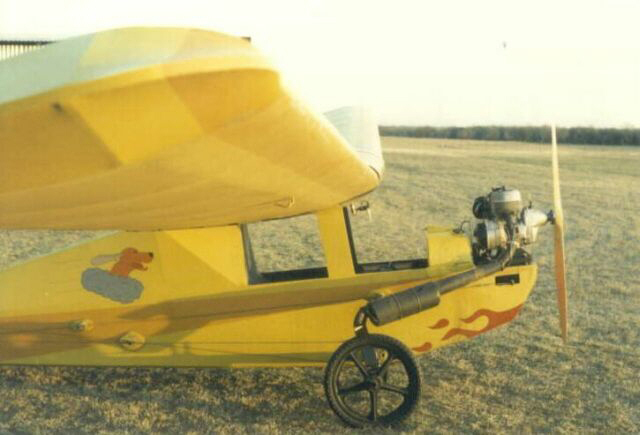
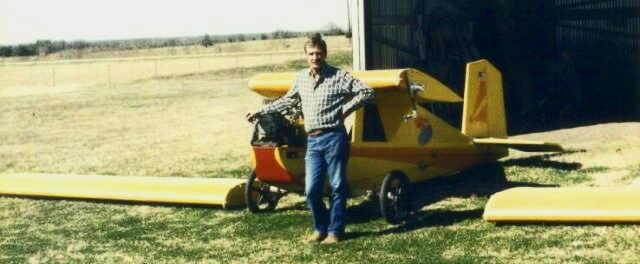
The photos above are from Dean Lowe of Waco, Texas. This Rotax powered Pup is yellow with orange trim and appears to be very much "per plans". This is the first Texas Sky Pup to be featured in the newsletter. Dean purchased the Pup completed and ready to fly. He bought the Pup for a very enviable price and the original plan was to fly it for a time, and then sell it. H has changed his mind and says he will keep the Pup. It was built by an A&P mechanic as some sort of school project but was never flown. The problem was with the school, not the Pup(probably some insurance or liability hassle). The Pup flies just fine and he has over 10 hour on it already. The first attempt at fast taxi and low hops resulted in a broken prop and minor damage due to taxiing in too much crosswind. For a time he had considered adding an extra nosewheel or skid to protect the prop (several Sky Pups have appeared with a small wheel under the nose, notably a Michigan Pup built by a club and flown by lots of different pilots). However, with a new prop and full power on takeoff, it flew great on it's first flight. It was als Dean's first flight in a taildragger. He says "Aerotec Props" in Dallas, Texas makes an excellent 60x28 prop for the Pup for $100 and it works great. Their phone number is 214-447-2010. Dean is having a trailer made for his Pup and hopes to have it in time for an air show in Denton, Tx on June 9th. Besides photos of his first flight, he also sent photos of his other "babies". 1930 Austin American automobile and photos of he and his son flying their "B Model"Weedhoppers.
The Smallest Sky Pup in the World
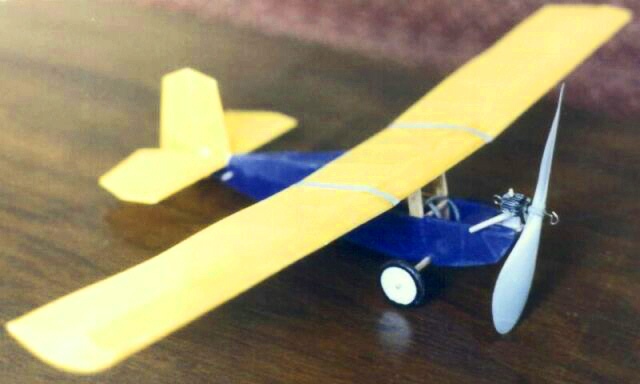
This photo was sent in by Sky Pup builder Bob Schafer of Boise Idaho. This peanut scale rubber powered model has a 18 inch wingspan, is 9 inches long, and is finished in the same colors as his full size version, blue and yellow. The model flies great, of course. Bob says his full size Pup is about 60% complete but that work had slowed down recently due to change in marital status. The theory is, he needs a woman around the house so he has a good excuse to go out and work in the garage. He says he will send photos of his full size Pup, and that he plans to attend the Oshkosh convention this year.
More on Hotwiring the Foam Ribs
The previous issue of Sky Pup News (No. 22) has a significant omission from the article on hot wiring the foam ribs. I failed to mention there is a special type of wire called "Nicrome" which is ideally suited for use as the cutting wire. It comes in different sizes and electrical resistances and is presumably available from RC model and homebuilt aircraft suppliers. the extra resistance built into the wire makes it much easier to get the correct heat without burning out the cutting wire and overloading the power source. I forgot about the Nicrome wire as I have used stainless steel safety wire because it was handy and I had been told it would work. My thanks to Terry Rockwell and Newton Borden for the reminder. Incidentally, Terry Rockwell reported that he has sold his Pup SN1863 featured in the July 1984 issue of Sky Pup News. the new owner is in Harrisburg, PA. Terry has since built and is currently flying a Kolb Ultrastar.
Oshkosh!
The 1989 EAA OSHKOSH CONVENTION is July 28th to August 3rd. Every year since the Sky Pup was introduced in 1983, there has been a Sky Pup on display at Oshkosh. So far, the prototype, Gerry Coppock's Pup, and my own have been seen there. This year, I will not be bringing mine because of my busy schedule and I don't know about Gerry. I do plan to be there at least a few days though. Look for Sky Puppers to be camped at "Ollies Birds Eye View" campground just outside the ultralight entrance. If there is anyone else out there who might be able to bring a Pup, PLEASE DO! We need you there to represent the Sky Pup idea to the world’s largest gathering of sport aviation enthusiasts. I'm sure you will have lots of interest from potential builders and from Sky Pup owners who are already flying. You don't even have to fly it. Static displays are always welcome (and less hassle). I only flew a few times last year during the uncrowded early morning periods. If you want to fly, you should have at least 10 hours in the aircraft in it's current configuration. You must be an EAA member to display an aircraft. If any questions about Oshkosh, please call me at 217-569-2131 after 10pm.
A LETTER FROM THE EDITOR
July 5, 1989
Dear Sky Pup Enthusiast,
It is time once again for me to apologize for sending this issue (#23) out so late. Several years ago, this would have been the April issue. I since changed the designation to ''spring'' to better reflect the wide variation in actual printing. This year it's even later than usual due to a lack of material being sent in during the beginning of the year. This is the second issue of 1989 and you should relieve two more issues this year. The next issue, ''July'' or ''summer'' would normally go out in August and includes news from the Oshkosh convention. I will definitely need builders and pilots to send photos, ideas, and articles within the next month if the ''summer'' issue of SKY PUP NEWS is to be sent out before ''Fall".
There is still plenty of interest in the Sky Pup and in the newsletter. This year, there were a number of new builders who learned about the Sky Pup from the back cover photo of my Pup SN2028 in the March issue of EAA Experimenters. I received quite a few letters from potential builders who had never heard of the Sky Pup before. If there are any subscribers who would be willing to sell the plan set, there are definitely buyers out there.
In spite of the continued interest, there will probably come a point in time when the newsletters have about covered every possible building tip, modification and idea that is relevant to an aircraft as simple as the Sky Pup. I don't think we have reached that point yet, so I encourage those who have not yet sent in something for the newsletter to get with it and join the litter! Send a photo and some details. Every Sky Pup should be featured in the newsletter at one time or another. Someday, these newsletters will comprise the history of the Sky Pup.
And now a word of explanation for new builders: If you are puzzled why many Sky Pup owners have not sent contributions to the newsletter, it's because you have not owned and flown one for several years. The Sky Pup has to be the easiest to fly, easiest to maintain, most trouble free ultralight ever designed. Routine repairs to the airframe which are common on the "bolt" together ultralights'' Just don't occur with the Pup. The rugged landing gear and large diameter tires eliminate damage from off-field landings which is the most common repair item on most ultralights. The end result is that Sky Pup pilots enjoy more trouble-free flying and have more fun! We know you will too! ..... Newsletters.....They're nice to receive in the mail, but not really essential for such a trouble free flying machine. There are about 100 subscribers, but at least 200 more Sky Pups have been completed and flown by persons who never received the newsletter.
This year, I have especially appreciated the low maintenance aspect of my Pup. I have been spending all of my spare time building a new 27 acre farmstead out of nothing. I am currently constructing a 40 x 60 horse barn with the help of my wife and a friend. I will also need a machine shed, hangar for the Pup, fencing, roads, and a mobile home to live in while we build a house. Land must be cleared for the runway. The planning and execution of these projects takes all of my spare time. If I had to spend lots of time working on the Sky Pup, I wouldn't get to fly! The engine got a new piston and rings this winter and I only had to varnish the prop and give the Puppy a bath and I was ready to go. It still flys great! In spite of my busy schedules I can still get in a little flying on weekdays, after work.
In closing this letter, I want to especially thank all of the builders who have sent letters and photos about their Pup. You have made the newsletter possible and you have helped motivate others to see their project through completion....Thanks!
Dan Grunloh
A TYPICAL SKY PUP HOLIDAY
by A. R. Clements
I wake up to a beautiful summer morning at our ultralight strip at Pit Meadows, B.C. Canada. My wife and I live in our 20 ft. motorhome (also homebuilt) during our B.C. summers and this is a lovely camping area. The grass strip is leased from a benevolent farmer who likes to see the 25 or so pilots enjoying their planes. My Sky Pup sits in its enclosed trailer with plastic covers for the wings. The farmland in the valley is surrounded by mountains up to 7000 ft. There is a 15 mile long lake, several smaller lakes, a couple of rivers, a few quiet roads, and lots of dykes dividing the valley.
This terrain, as you can imagine, makes ideal “Sky Pup” flying. By the end of summer, all I would have to do is make a low pass over one of those high speed ski boats, and I had a race on my hands. Sometimes they would leave me behind so I would make a climbing turn back down the river to find something more my speed. Some of the boaters got to recognise my “Green Machine'' and they would stop and wait for me to zoom on them which was the signal to start the race. One day I came screaming over a dyke (doing all of 30 probably) and there was one of these racers with a half dozen young people aboard. I banked steeply and went alongside. We raced for a mile down the river at ever increasing speeds before I turned away. They were waving and grinning at this 60 year old Sky Pup pilot. I wave back doing my porpoise act which is raising and lowering the tail rapidly (I wonder if they think the plane is out of control).
I always wave to people walking on the dykes and they wave back. When I was a kid I would shout up to a passing Cub or Champ. Now I can shout back! I know the regs say to stay 500 ft. from the public, but when a farmer waves and I feel he wants to see more, I mow his grass a little. If they have a smooth pasture, I land and let them see the Sky Pup up close. Then away I go again, just like Lindberg in the old days. Sometimes I photograph their homes from the air and they are delighted. It helps to make good P.R. My Pup is the quietest ultralight around and I think the people like that.
There are many birds in this area and I find myself in amongst flocks of geese and ducks and even sparrows and swallows. They don't seem to have any trouble avoiding me. The big and slow flying Great Blue Heron gives me the most concern as he gets into a great panic. Once, while flying alongside the mountain, an adult Bald Eagle came at me as though to cross my path. He saw he wasn't going to make it and did a fast wingover and passed behind the tail of my ''Green Machine'' (phew!). Another time, while flying along the river, I was chased first by one Osprey and then by another. I was laughing until I saw they were gaining on me and looking very angry. So it was back to full power again.
I generally go up high in the early morning, climbing over and following the steep mountainside until I'm at 3000 ft. or so. With snow-capped mountains, and lakes and rivers below, I can see forever. It’s like I am the only person awake in the whole world.
What a delight to have built and to fly a "Sky Pup".
Sincerely,
A.R. Clements
Box 2076
Sechelt, BC Canada VON-3AO
(for background information on the ''Green Machine'' see issues no. 17, 18, and 21
Minor Repairs to "Simple Happiness"
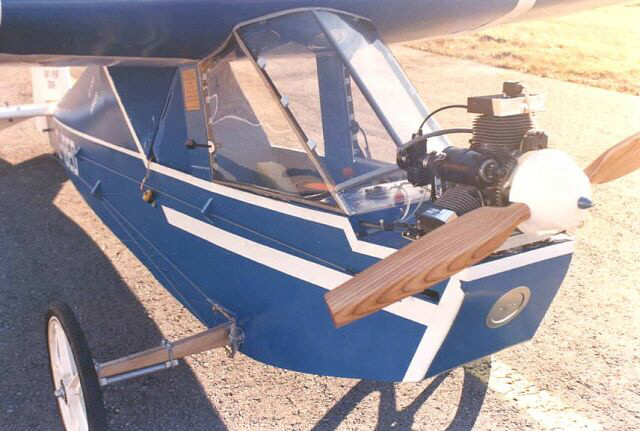
Andre St. Pierre from Pointe du Lac Quebec (issue #21) reports he has made some modifications and repairs to his Pup SN 3099. He had originally built a fuel tank into the compartment behind the backrest foam panel. A filler neck through the side panel was AB plastic. He discovered too late the fuel will dissolve ABS plastic. The problem was easy to fix by replacing the tube with a PVC plastic pipe which is not affected by fuel according to his tests. In the process of making these repairs, he discovered cracks in the lower part of the backrest foam panel! The cracks were apparently caused by excess "G" loads applied during hard landing. He repaired the backrest by adding a foam sheet and fiberglass to the affected portion of the lower backrest. Fellow Canadian builder Jean-Claude Hivon (issue #19), has noticed some deformation of the backrest on his Pup when taxiing on rough ground. He added a plywood lamination on the complete underside of the backrest foam panel on his "Ski-Pup" which cured the problem. Unfortunately, he forgot to mention this change to Andre when was advising him on the construction of "Simple Happiness". It is recommended that Sky Pup owners check the condition of this area whenever the fuselage is opened up for some reason or after a particular hard landing. Apply pressure strongly with the hand from the upper side to check for cracks....and take it easy on those landing!
Rotax Maintenance Video
Paul Rasmussen of Des Moines, Iowa, recently purchased the Rotax Video from L.E.A.F. and sends along the following report: Although there was some good information for new engine owners, overall, the $50 tape was a disappointment. I think the L.E.A.F. catalog contains more information about timing and tuneup etc. Here are some tips from the video.
1.) The Rotax 277 runs rich at full power but leans out in the midrange. I suspect the engine was designed to run at a higher power setting than most Sky Pup pilots need and we therefore spend more time in the lean midrange settings. I plan to change the needle one notch richer and see if it helps the overheating problem.
2.) The body of the carb should be parallel with the cylinder head (straight up and down in level flight).
3.) The diaphragm fuel pump should be mounted vertical with the small vent hole in the cover on the low end.
Paul says he recognized Neil Huizenga's Pup SN 1092 (see issue #22) as having been feature in the October 1985 issue of "Ultralight Aircraft" magazine. It's a famous Pup! It probably stimulated many new builders to "join the litter". As to the bent carb needle reported by Greg Pardee in the last issue, Paul and I agree, it should be replaced rather than straightened. It will always be slightly crooked, and could cause the throttle to stick at the worst time, such a taxiing. Paul also reports that his Pup, featured in issue #14, is now 3 years old and still going strong. He may not get to fly as much this year as he is expecting an addition to the family.
Miscellaneous
I recently received a phone call from Ed Toner, 52 Newbury Rd., Howell, NJ 07731. He was looking for information about Sky Pups completed and flying. He has built an accurate scale gas-powered free flight model of the Sky Pup. His model is to be featured in a popular mode aircraft magazine and he wanted to include photos of the real thing. Possibly Newton Borden or one of the other builders on the east coast will soon find their Pup pictured in a national magazine.
Mark Walker and Jim Carpenter of Tampa, FL report that their Sky Pup is nearing completion.
The fuselage and one wing is covered and the KFM engine is mounted. They have to cover the second wing and hook up the controls and instruments. Mark says everything seems to take longer than expected but they are hanging in there and it shouldn't be too long now to completion.
Vince Jackson of Winterset, Iowa, writes that he is new to the Sky Pup scene but has started to help a friend complete a Sky Pup which stalled out during the wing construction. He was working on the tail feathers at the time of his writing. This Pup is one of many that are still under construction and will no doubt be flying in the future.
New Sky Pup builder down under. Mr. W. Laan from Titirangi, New Zealand wrote for information about plans for the Pup. I was able to put him in contact with someone on the old plans buyers list from New Zealand who had not actually begun construction. He now has plans and a full set of newsletters. No one can accurately say how many Pups are being built around the world. Sky Pups will probably keep appearing from workshops for many many years.
SKY PUP NEWS

Newsletter No. 24 December 1989
- First KFM Powered Pup has Flown
- Oshkosh 89 and News from Gerry Coppock
- News from Al Clements of Sechelt B.C.
- Modifications to Texas Sky Pup
- Excerpts of a Letter from Newton Borden
- Miscellaneous
-------------------------------------------------
SKY PUP NEWS is a quarterly newsletter for builders of the Sport Flight “Sky Pup”. The purpose of the newsletter is to provide for the open exchange of information and to encourage builders t share their experiences of building and flying the Sky Pup. Beginning with this issue, the newsletter will be written by Sky Pup builders and enthusiasts. Unless specifically stated, al ideas, suggestions and building tips are strictly the opinion of the contributor and have not bee approved by Sport Flight Engineering Inc. No warranty is made as to the airworthiness o suitability of modifications or building tips. When in doubt, you should follow the plans as clos as possible and contact Sport Flight Engineering if you have questions. SKY PUP NEWS i compiled and distributed by Dan Grunloh…Rt 2, Box 82, Potomac, Illinois, 61865. Subscription are $7.00 for the calendar year ($10.00 overseas). If you want to talk about the Sky Pup, or abou airplanes and homebuilding in general, please feel free to call me at (217) 569-2121 late evenings.
Please keep sending your letters and photos.
*** Important notice to subscribers…. This issue, No. 24 is only the third issue published for 1989 due to a decline in the “news” to be reported. There have been lots of new builders but fe reported completions this year. Subscriptions for 1989 will be extended to include issue No. 25, whenever it comes out. Sky Pup News will henceforth be published irregularly 2 to 3 times pe year. Subscriptions are still $7.00 for 4 issues. Back issues are $1.00 each in quantity.
First KFM Powered Pup has Flown

Mark Walker and Jim Carpenter of Tampa, FL have completed and flown the first KFM powered Sky Pup to be reported in this newsletter. The fuselage is tan and the wings are orange. The fabric cover was Dacron sheath lining and the quality of finish appears to be excellent. The 2-cylinder opposed 25HP engine required modifications to the exhaust system for mounting on the Pup. the gell-cell battery for the electric start is mounted on its side under the seat. Empty weight is 230 lb and the Pup is very much “per plans” except for the addition of a tailwheel. An electric generato type airspeed is mounted under the wing outboard of the wing attachment joint. The first flight was in October 1989 but the engine would only turn 5500 RPM so takeoff and climb was poor. The engine should turn 6200 RPM at full throttle. After some study it was decided to remove the 7 inches of exhaust pipe which had been added between the engine and the muffler. This was done and the engine returned to full power RPM. However, the weather has not permitted additional flight testing with the corrected exhaust. We will have more details about the project when the are able to fly again.
Oshkosh 89 and News from Gerry Coppock

First the bad news. There were no Sky Pups on display at Oshkosh ’89. Lots of builders and owners though. The photo at left shows a typical scene at the Sky Pup builders headquarters a Ollie’s Birds Eye View campground. None of us were flying so there was no need to refrain from recreational beverages in the hot weather. A good time was had by all. Gerry and I had both flow at Oshkosh on previous years. However, this year we both were working so much overtime that we couldn’t prepare and bring our Pups. Oshkosh was a much needed vacation. There were 15 to 20 builders and owners from all over the USA and Canada at the convention. Several builders have planned to bring their Pup but couldn’t make it due to lack of airtime or the trailer was not yet complete. Still it was a treat for me to meet friends in person that I had known for years but only through letters and phone calls. I didn’t keep a list of names but thanks to everyone for stopping by.
Also in the news, Gerry says he had a forced landing in his “Doghouse” on the shores of Lake Michigan. The photo above shows there was no place to land but in the water. The impact tore out the bottom of the fuselage but the damage can be repaired. The sudden engine stoppage was traced to a 2-piece fuel filter which could be disassembled and cleaned but had never been safety wired. After many years of flying it decided to come apart at the worst possible time. Many of you have probably also flown too low over hostile terrain on a few occasions. It is a risk you should avoid. Gerry has built a new workshop and begun construction of a 2-place, high wing, tub fuselage, prototype aircraft called the Babe-E. His new company is called High Wings Inc. He has been working on the design for some time with the help of Sport Flight and hopes it will be a improvement over other homebuilts in the area of cost and performance.
News from Al Clements of Sechelt B.C.
Al reports that though he only flew 3 months in 1989, he accumulated 50 hours of good fun flying(most of us have trouble putting on 50 hours in a whole year). His bird has 147 hours total. See newsletters No. 18 & 21. The Pup is as good as new with no maintenance needed this year. He did have an outer axle shackle pop off on a hard landing and so broke his homemade prop. It was no problem as he had a spare store-bought prop. Al has since made another 2-blade and a 4-blade prop but hasn’t tried them out yet. He says he puts “silicone” on the rubber engine mounts t keep them from chaffing. It also works fine on the exhaust joints. It doesn’t burn off as you would think. He is building up the forward deck with an engine cowling but feels it detracts from the “Flintstone Plane” appearance. A new axle spring of laminated ash and oak has been built. the straight ash axle was too springy and the former oak axle was too stiff. He has decided to remove the tailwheel as the landing runs on a bumpy field are too long.
Modifications to Texas Sky Pup

Dean and Wayne Lowe have made a few modifications to their Pup which was featured in newsletter No. 23. They have added a steerable tailwheel, new muffler brackets to reduce vibration, and regular aircraft wheels and brakes. The wood rudder bar was replaced with an assembly which includes the function of the rudder and provides for individual hydraulic to brakes. Brake pressure is not sufficient to stand the Pup on its nose, but it can be adjusted so.
The engine mount was lowered 0.5 inches and moved back 1.5 inches to help the C.G. The head gasket was replaced with two head gaskets which reduced the compression and the vibration on the Rotax 277. Dean also says they have purchased a Ryan ST replica ultralight. It’s a low wing, single place with a tube fuselage, Stits fabric, ailerons, and Rotax power. A photo of the aircraft in flight was included (the design was featured in the March 1985 issue of EAA Light Plane World p 25-28). The Ryan is for sale for $2500. If anyone is interested call (817) 829-2089 after 6:00 pm.
Excerpts of a Letter from Newton Borden
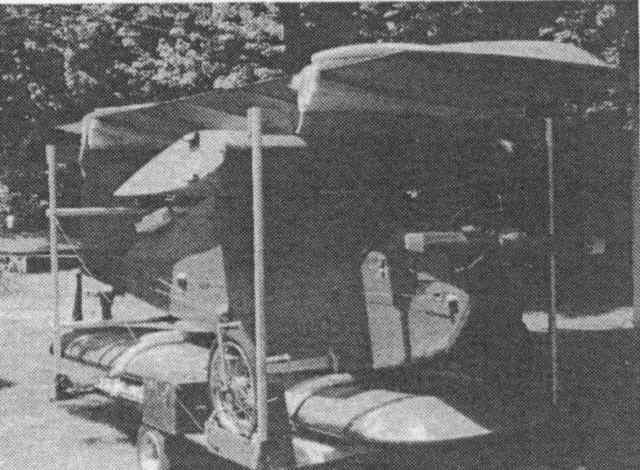
“Dear Dan,.. Just a few lines to let you know how things are going. I built a lightweight trailer and towed my Pup down to the ultralight fly-in in Montery, NY. I went with a friend who has a CG Hawk. It was a 12 hour tow each way. It was very hilly, hazy country, but I managed to get some shows with my video camera mounted on the Pup. I had the only Sky Pup at the fly-in but did meet 2 Sky Pup builders, Don Palmer and Bert Howland. Also last week I had an engine failure due to plugged fuel line and air sucking through my sight gauge (which was connected directly to the fuel supply line). The line would fill with air bubbles and the engine would quit. Then the line would fill with gas, I would restart and run for about 2 minutes until it would quit again. This went on for 5 to 6 restarts losing altitude and battery charge each time. I made it back to the field with just enough altitude for a downwind landing. Apparently the outlet of the fiberglass tank was being plugged with a gooey residue by pump pressure but would fill with gravity alone. After 3 summers, my Pup looks pretty messy. The orange color has faded, the latex cement is turning brown and the urethane is peeling. Maybe I’ll recover it this winter. It’s a pain in the butt to remove the wing each time after flying, so I just tie it down and hope for no bad storms. I almost made it to Oshkosh this year with my Pup. I was planning to leave Montery, NY and go direct to Oshkosh but my buddy convinced me it was too long a haul. Hope you and your loved ones are in good health. Sincerely, “One of the Pack”,…Newton.
Miscellaneous
Doug Rhode of Manitowac, WI called to say he had bought a completed Sky Pup from Ken Appleby. The Zenoah engine ran hot on static runup so the Pup was never flown. Doug has also purchased a Konig 3-cylinder radial. The Pup weighed only 202 lbs with the Zenoah so with the Konig engine this should be one of the lightest Pups flying. Look for the Pup at the Oshkosh convention.
Andre St. Pierre of Quebec, Canada has flown his Sky Pup a total of 110 hours in 1989 according to Paul Pontois. WOW!! That’s a lot of flying. New builders take note next time someone suggests your 2-axis taildragger will be limited too much by crosswinds. Several Pups ar approaching 500 hrs. How many plans-built aircraft actually fly more hours than they took to build?
Rumor has it that Robert Kenne of Houston, TX has completed but not yet flown his Sky Pup which has added wing spoilers and attachment blocks for floats.
You may have noticed the address for Sky Pup News has not changed as predicted in the previous newsletter. Development and construction of our new farm has taken longer than expected. The move will occur in 1990 or else!
Some of the new builders on our list:
Guenther Schmidt of Seattle, was (has Ultra 275 engine)
Howard Fortner of Houston, TX (looking for used engine)
David Ardoin of Zille Platte, LA (ready for cover)
Ted Kowalski of Strongville, OH
George Cox of La Palma, CA
Chris Valdivia of Rosemond, CA
Allain Hale of Sarasota, FL
Fred Anderson of Manhattan Beach, CA
Claire Smith of South Haven, MI
SKY PUP NEWS

Newsletter No. 25 June 1990
- New Sky Pup from Maine
- New Blue Pup from Houston
- Pennsylvania Pup for Sale
- Some Tips on Your First Flight
- More Miscellaneous
- News from Quebec
- Newton Borden
- Miscellaneous
-------------------------------------------------------------------------------------------------------------------
SKY PUP NEWS is a quarterly newsletter for builders of the Sport Flight “Sky Pup”. The purpose of the newsletter is to provide for the open exchange of information and to encourage builders to share their experiences of building and flying the Sky Pup. Beginning with this issue, the newsletter will be written by Sky Pup builders and enthusiasts. Unless specifically stated, al ideas, suggestions and building tips are strictly the opinion of the contributor and have not bee approved by Sport Flight Engineering Inc. No warranty is made as to the airworthiness o suitability of modifications or building tips. When in doubt, you should follow the plans as clos as possible and contact Sport Flight Engineering if you have questions. SKY PUP NEWS i compiled and distributed by Dan Grunloh…Rt 2, Box 82, Potomac, Illinois, 61865. Subscription are $7.00 for the calendar year ($10.00 overseas). If you want to talk about the Sky Pup, or about airplanes and homebuilding in general, please feel free to call me at (217) 569-2121 late evenings.
Please keep sending your letters and photos.
New Sky Pup from Maine

Rev. Earl R. Gray of Kezar Falls, Maine has completed and flown his Sky Pup shown above. Firs flight was May 30, 1990 and he says the whole process was fun from beginning to end. Photo taken during the construction process show excellent workmanship. The initial flight was tape on a camcorder at Air Tech in Limerick, Maine. The colors are white and yellow. The leading edge of the wing, fixed tail surfaces and lower fuselage are yellow, while wing, movable tail surfaces and turtledeck are white. The motocross wheels are white with blue tires. The fabric is Dacron sheath lining as can be seen on the white areas where the writing on the foam is quite visible. Earl found that the yellow fabric on the blue foam results in a slight greenish tinge in the foam areas. The engine is a Cuyuna UL-02 with Ultraprop. The horsepower (35) is more than prescribed, but it is smooth and he doesn’t have to give full throttle. The weight and balance figures out OK. For the extra 20 lbs of engine, he mounted a fiberglass fuel tank in the wing center section. The empty weight came out to only 197 lbs which gives a gross weight of 387 lbs. This Pup is an excellent example of low empty weight that is possible with the Sky Pup. Earl says he built his landing gear out of oak and damaged it on his first day of test flying. A wind gust picked up one wing and dumped him on the runway hard and broke the landing gear and wheel. He has since ordered new landing gear of ash. There was very little damage to the plane. The lesson here is that the first few flights should be made in calm conditions, and remember to keep plenty of airspeed at first especially when near the ground. Earl will be retiring soon so all his playthings are for sale including the Sky Pup, a KR-1, and a KR-2. See his address in the previous issue (no. 24).
New Blue Pup from Houston

Howard Fortner of Houston, Texas sent these photos of his Rotax powered Pup which made it first flight on Sunday, June 3rd. A cowling has been installed and a ballistic parachute is mounted on the left landing gear. He installed a CB radio and battery, with the antenna built into the vertical stabilizer. The airspeed indicator pitot tube runs through the aft ribs all the way out to the last wing compartment with a quick disconnect at the wing joint. A storage compartment was built into the turtledeck. The finish and color is “Silithane” sprayed on. The color is dark blue on the wing and horizontal tail and light green on the fuselage and vertical feathers. He and his wife enjoyed the project very much and it was educational as well. He did have to search for some of the dimensions. The sewn together hinges were a real pain. A 2-1/2 gallon fuel tank is mounted recessed into the forward deck and another fuel tank is mounted in the centersection to the right of the fuselage to make leaks and spills more visible. Wires were run to the top of the tail section for possible addition of a strobe. There will be a windshield. Instruments are mounted behind the centersection spar with airspeed, altimeter, CHT, RPM, and a turn indicator made from clear hoes and colored water (the slip-skid indicator will be useless on a Sky Pup). The first take-off was unexpected. It was windy and turbulent, and he had only minimal fuel. After several attempts at crosswind landing, he decided to land in a plowed field. However, an unseen drainage ditch caused damage to the landing gear. Howard took his training in a Citabria, but says his first Sky Pup flight was much too bumpy to do anything but hang on and try to get back down (the lesson is, don’t fast taxi on a hot day in the middle of a sunny afternoon. Wait for early evening). the total cost for this Pup was $3200 including everything like drill bits, brushes, cleaners, parachute, and mistakes. The total time was about 600 hours or 4 months. He says he could do another on for considerably less time and money. Howard sent along his thanks for my help and advice, an also want to thank his friends, neighbors, and wife for all their understanding and help on the project.
Pennsylvania Pup for Sale

Thomas Bird of Bellefonte, PA sent photos of his Cuyuna powered Sky Pup which has been flown for about 20 hours. The color is mostly white. The leading edges of the tail, wheel covers, and cockpit interior are blue. The quality of the finish is superb and the trim stripe gives it an overall very sharp appearance. Tom wants to sell his Sky Pup. The price is $1995. Write to Tom at, R #4, Box 128, Bellefonte, PA, 16823 or call 814-355-9240.
Some Tips For Your First Flight
Over the last few years, I have received a number of reports of difficulty with the first flight resulting in minor damage (usually the landing gear). In almost every case, the cause has been failure to follow the instructions from Sport Flight, or failure to follow common ultralight flying principles, or failure to follow procedures common to all aircraft.
Never conduct fast taxi tests with and aircraft that is not totally ready to fly. That means the seat belt must be installed, there must be enough fuel onboard for at least 30 minutes, and the pilot should have a helmet. A number of builders have found themselves in the air before they were ready. You should have at least a 1000 ft runway with no obstacles. Grass is much better than pavement.
Test flights should be conducted only in the calmest conditions. (A direct quote from the Sky Pup manual.) Regardless of your experience in other aircraft, there should be no wind. In calm conditions you can fast taxi both directions and land either direction if needed. Also if an off-field landing becomes necessary, you are not limited by the wind direction. Why take chances? The best times are early in the morning and late in he evening. In the morning, conditions will gradually worsen as the wind and turbulence picks up due to heating from the son. Early evening is best as the conditions will usually improve toward sunset. If you are worried about landing in the dark, then takeoff so you will run out of fuel before darkness begins. At least you will have light for your forced landing.
Avoid flying close to the ground at low airspeed. Many experts suggest you make low hops before climbing to altitude. Others disagree. The idea is to find out if the plane is in reasonable trim and will maintain level flight without excess control deflection. Only a few feet of altitude is needed for this test. As long as the controls are somewhere near the middle of their range, you are OK. The most common cause of landing gear damage on the first flight seems to be low airspeed on initial hops. If you are 10 to 15 up at minimum airspeed, and you drift off the runway, the controls may not respond quickly enough to straighten it out. Keep those initial hops low and only in calm conditions!
For the initial takeoff. The best technique is to keep the tail about halfway between level attitude and tail on the ground and wait for it to lift off by itself. If it doesn’t, then add more back stick. Once you break ground, let the sick come forward to build up more speed. You will feel the controls become more responsive. If the stick is well back or far forward in level flight, your CG or trim may be off. Do not climb steeply on the first flight. It’s possible to have the nose so high it will only mush along at low airspeed and not gain altitude.
Climb straight out to several hundred feed before making any turns. The rudder control is very effective and you should have no problems getting the feel of it. Notice if the rudder controls are near the middle when in level flight. A strong turning tendency indicates wing or vertical tail misalignment. If you are holding too much back pressure or forward pressure on the stick, you may have to adjust the CG or the tail incidence. Before your first landing, climb to 500 to 1000 feet and explore the slow flight characteristics of your Pup. Reduce power and let the nose come down for a normal glide. Take note of the stick pressure and position and aircraft attitude you will be using in a landing approach. Next, ease the stick back farther until you begin to feel an increased sink rate (and probably more stick pressure). Avoid this condition when near the ground.
Landing is the easiest part. Make a long straight approach with partial power and normal glide speed. Adjust the throttle so you will make the runway. You only have to fly level close to the ground and reduce power when the wheels touch. Your first landing may be fast so be careful of lowering the tail too soon or it will takeoff again……the next step is to enter your first flight in a log book!
More Miscellaneous
Clyde French of Durham, NC (formerly Grinnel, Iowa see issue #20) will be moving to Texas. His new address is: XXXXX) He sent information about the fabric cement he used for covering his Sky Pup. It can be ordered directly from Chicago. The price is about $15 per qt. or $55 per gal.
------------------------------------------------------------------------------------------------------------------
Oshkosh '90 is July 27th to August 2nd. I plan to be there through the first weekend at least but probably will not have my Sky Pup. Check at Ollies Birds Eye View Campground near the Ultralight Entrance.
The mailing address for the Sky Pup News will change to Loda, IL late this summer. All subscribers will receive a notice of the new address before we actually move.
Dan Grunloh
News from Quebec
Andre St. Pierre sent these photos along with news from the far north. On the left is his Pup mounted on skis. He made very few flights this winter on skis because of the poor weather. H started flying on wheels again on March 12. The photo on the right is a 2-seat offspring of the Sky Pup completed by Jean-Claude Hivon called the Caronet. The aircraft was designed by Rejean Carion, a very experienced model airplane builder from Rimouski, who learned about the Sky Pup from his friend Regis Castonguay (another Sky Pup builder, issue #5). He was impressed by the simplicity and ease of construction and decided to make up plans for a 2-seater based on the Piper J3 measurements. Most of the airframe is similar and the airfoil is the same except slightly thinner. Unfortunately Rejean fell sick during construction of the plane and learned that he had terminal cancer. He kept trying to complete the project but had to give it up about half was through due to his worsening illness. Jean Claude heard about the project and decided to try and finish it while Rejean was still around to see it fly. Jean Claude was an excellent candidate as he is a farmer who has lots of free time in the winter and had previously built a Sky Pup.
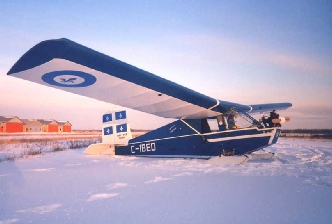
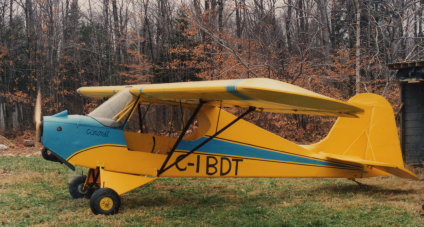
The aircraft was completed and flown last Fall. He was able to show a video tape of the first flight to Rejean just one week before he passed away in the hospital. The plane is named in his memory. Jean Claude used the airplane very often on skis this winter and it would outfly every ultralight in the surrounding area. Andre says he is thinking about building one himself as 2-place ultralights of a max gross weight of 1060 lbs will be legal in Canada next year. The blue and yellow, Rotax 503 powered aircraft has a 36 ft wingspan, 10 gal fuel capacity, and has an empty weight of 420 lbs. Top speed is 100 MPH, cruise is 60 MPH at 5200 RPM, and it stall at 30 MPH.
Newton Borden
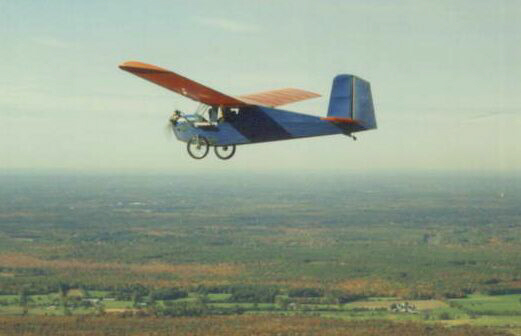
Newton Borden of South Weymouth, MA sent this terrific photo of his Koenig powered Pup and a copy of a local newspaper story about his bird which featured a large color photo, on the front page no less! I just had to include this photo because good air to air shots are hard to get and they really show the Sky Pup at it’s best in the air and having fun. Everyone should have at least one photo like this to send out to friends. Best results are obtained if the terrain is showing below the aircraft and if the aircraft is slightly above the horizon. It also helps to have a good clear sunny day.
Miscellaneous
Greg Pardee of Owossi, MI announced in the last issue that his Sky Pup is for sale less engine for $900. See issue #18. He is building a Mini-Max. He enjoyed flying the Sky Pup and discovered that the engine mount used on the Mini-Max works great on the Pup. The 3/8 plywood and soft mounts completely eliminates vibration. He highly recommends this mount which is available from Team Inc. for about $20.
Raymond Maynard of Lake Ann, MI (issue #17) is parting out his Sky Pup and will sell the Rotax 277 engine and Sky Pup plans. While attempting to land on a narrow airstrip, he hooked the landing gear and quickly found himself upside down. He is getting along in years, and at the insistence of his wife, has decided to retire from flying. His address is: Rt. 1, Box 561, Lake Ann, MI 49650 (616) 275-7628
Brain Helsaple of Seiad Valley, CA wants to sell his Pup (issue #18). The Pup has been hopped but not actually flown at altitude. He has about 8 hours taxiing with various wheels and brakes but almost zero actual airtime (and 3 years in the garage). The engine is a 386cc Rotax opposed twin with belt reduction. His address is: PO Box 521, 45013 Hwy. 96, Seiad Valley, CA 96086
Mark Walker and Jim Carpenter of Tampa, FL must sell their KFM Sky Pup reported in the previous issue #24. They are both having medical problems. The Pup has 5 hours flying time, is easy to fly and very stable. The asking price is $3200 due to the expensive KFM engine. Write to Mark at, 8815 Higbie Place, Tampa, FL 33615
John Komlosy, 235 Blue Ridge Dr, Boulder Creek, CA 95006 has two zero time Cuyuna 215 engines for sale or trade and wants something like the 3-cylinder Koenig.
Original Newsletters edited by Dan Grunloh, electronic edition compiled by Edwin Lelieveld and Roger Ford.
